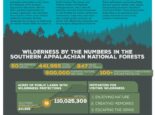Fighting for the South’s wildest places
What makes Southern forests wild?
Southern Appalachian national forests are made up of millions of acres of incredibly beautiful and diverse landscapes. These forests include dozens of Wilderness Areas, which are places Congress has given added protection from development. Unlike tracts of national forest land that have been logged, farmed, or mined, Wilderness Areas have been mostly untouched by industry, making them unique and special places. Protecting remaining wild, public places is especially important in the South, where populations and development are quickly growing.
The importance of wild places
Wild places are critical to Southern Appalachian forests. These areas offer visitors calm, solitude, and unique recreational experiences, like hiking, paddling, hunting, and camping. SELC helped fund a recent study by the University of Georgia’s Warnell School of Forestry and Natural Resources that showed a vast majority of Southerners see the incredible value of protecting these special places; 88 percent of those surveyed, from across the political spectrum, said they want more wilderness areas in the region.
Wilderness Areas and other protected public lands also provide crucial habitats for wildlife, including some of the region’s most endangered and rare species. These places are often home to old-growth forests as well, which can be centuries old and provide immeasurable benefits to national forests. Stands of mature trees filter water for communities living downstream and are great at storing carbon – a quality that has become increasingly important as climate change continues to have growing impacts on people in the South and around the world. Protecting areas with old-growth stands is an integral part of a climate change solution.
Wilderness areas and other protected lands are some of the South’s most unique, pristine and diverse landscapes. These incredible places deserve to be preserved and enjoyed for generations to come.
Sam Evans, SELC Senior Attorney and Leader of SELC’s National Forests and Parks Program
Advocating for higher levels of protection
Sadly, some of these special places are threatened by reckless road-building and timber harvesting projects. SELC is committed to protecting these important areas and works with U.S. Forest Service leaders during the creation of forest management plans. These plans set the long-term vision for a national forest, and offer an opportunity for SELC and other stakeholders to advocate for wild places to be protected from future industrial projects.
We are also pushing for more permanent protections on Capitol Hill by urging Congress to create additional Wilderness Areas and National Scenic Areas. We are currently advocating for added protections in Virginia through the Virginia Wilderness Additions Act, which will add a total of 5,600 acres to two existing wilderness areas within the George Washington National Forest: the Rough Mountain Wilderness area and the Rich Hole Wilderness area. We are fighting to create the Shenandoah Mountain National Scenic Area as well, which would protect around 90,000 acres in the George Washington National Forest.
These increased levels of protection keep some of the most pristine areas of the Southern Appalachians shielded from extractive industries like logging and fracking, ensuring that future generations can enjoy the benefits of the South’s wildest places.
Recent news on the South’s wild places
Additional Resources

